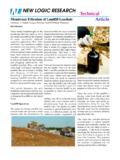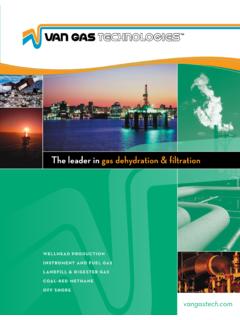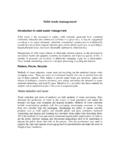Transcription of P McKendry, J H Looney, A McKenzie - CSCHI
1 Managing Odour Risk at landfill Sites: Main Report P McKendry, J H Looney, A McKenzie MSE First Published 2002 ISSN 1478-0143 Copyright of this document remains with MSE Ltd & Viridis 2002 This project was funded by SITA (UK) Ltd under the landfill Tax Credit Scheme. The full report entitled Managing Odour Risk at Landfills Main Report is available for download from the following web sites: Viridis ( ) and MSE ( ). Viridis was the Entrust Approved Environmental Body (AEB) responsible for the project and the work was undertaken by Millennium Science & Engineering Ltd (MSE). The authors wish to acknowledge the assistance of the Environment Agency in reviewing the air dispersion modelling aspects of the project.
2 MSE is committed to optimising energy efficiency, reducing waste and promoting recycling and re-use. In support of these goals, this report has been printed on recycled paper, comprising 100% post-consumer waste, manufactured using a TCF (totally chlorine free) process i TABLE OF CONTENTS TABLE OF CONTENTS i Abbreviations iv Summary of Conclusions v 1. Preface 1 History 1 Related landfill Tax Funded Projects 1 2. Introduction 1 Waste Management Context 1 Regulatory Framework 2 Planning Controls 2 Waste Management Licensing 3 Regulatory Guidance 3 Public Acceptability 3 3.
3 Odour and Odour Measurement 4 Olfactory Response and Odour 4 Odour Measurement 5 Odorous Compounds in landfill Gas 5 4. landfill Odour Sources 7 Introduction 7 Waste Transport Vehicles 7 Landfilled Wastes 8 Leachate 8 landfill Gas 9 5. Site descriptions 9 Introduction 9 Waste Input/Waste Types 9 Site Design and Operational Regime 10 Terrain 10 Proximity to Habitation 11 Potential Off-Site Odour Sources 11 6. Odour Complaints Data and Questionnaire 12 Odour Complaints 12 Odour Questionnaire 12 Analysis of Survey Results 13 Alternative Potential Odour Sources 14 7.
4 Regional Wind Flow Patterns 14 Physics of Wind Flow 14 Terrain 15 Air Dispersion Models 20 Application to Landfills 21 ii 8. Monitoring of Emissions 21 Definition of Source Terms 21 Monitoring Procedure 22 Measurement of Emission Rates 22 Sources Monitored 25 Monitoring Programme 26 9. Air Dispersion Modelling and Results 26 Graphical Outputs 26 General Effects 27 Location Specific Effects 32 Site Specific Interactions 39 Probability of Odour Events 39 Summary and Conclusions 44 10.
5 Management System Tool 45 Introduction 45 Odour Control Guidance 45 IPPC, BAT and Odour 45 Mitigation Options -- General 51 Mitigation Options Specific 53 Further Work 55 11. Conclusions 55 Study Background 55 Odour, Measurement and Complaints Data 55 landfill Odour Sources and Measurement of Emissions 55 Air Dispersion Modelling 56 Management Options 56 12. References 57 Appendix 1 Guidance on Odour and Odour Control Appendix 2 Odours and BAT Appendix 3 Properties of Selected Mercaptans and Hydrogen Sulphide Appendix 4 Calculations and Conversions Appendix 5 Details of Site Characteristics Appendix 6 Odour Questionnaire Appendix 7 Emissions Monitoring Protocol Appendix 8 Measurement of Emission Rates iii Figures and Tables Figure 1: Normal distribution of the sense of smell within a population 4 Figure 2: Comparison of the ODT for selected LFG trace components and their reported concentration in LFG 6 Figure 3.
6 Two stages of the anaerobic decomposition of complex organic wastes 9 Figures 4 7: Regional Wind Flow at Site V2 at a height of 10m 16 Figure 8: Wind Flow over landfill Flank (or Escarpment) 19 Figure 9: Schematic of Flux Tent 22 Figures 10 17: Wind speed variation 28 Figures 18 20: Surface Roughness 29 Figures 21 26: Wind Direction without Terrain 30 Figure 27: Fluctuations with Terrain 32 Figures 28 34: Wind Direction and Terrain H1 33 Figures 35 42: Wind Direction and Terrain V2 32 Figures 43 48: Wind Speed and Terrain H1 34 Figures 49 60: Wind Direction, Wind Speed and Terrain V2 37 Figure 61: Annual Wind Rose, Site P3, 2001.
7 40 Figure 62: Annual Wind Rose, Site V2, 1997 41 Figure 63: Annual Wind Rose, Site H1, 1999 42 Table 1: ODT of Selected LFG Trace Components 5 Table 2: Selected Sulphur Containing Compounds in LFG (50% methane) 6 Table 3: Waste streams accepted by sites and total annual input (m3) 10 Table 4: Summary of Site Design Characteristics 10 Table 5: Summary of Questionnaire Statistics 13 Table 6: Beaufort Scale-Specifications and Equivalent Speeds 14 Table 7: Roughness values for different land use surfaces 21 Table 8: Measured Emission Values for Methane from landfill Odour Sources 23 Table 9: Calculated Mass Emission Rate for Methyl Mercaptan 24 Table 10: Combinations of Typical Emission Sources (based on Mercaptans) and the Cumulative Emission Rates 25 Table 11: Cumulative Effect of Combined Controlling Factors on Percentage Exposure to Odours 43 Table 12: Odour Risk Assessment Matrix 46 Table 13: Odour Control: Design and Operational Management Options 47 Table 14.
8 Specific Operational Options to Reduce Odour Impacts 54 iv Abbreviations BAT Best Available Techniques EA Environment Agency EHO Environmental Health Officer FID Flame Ionisation Detector IPPC Integrated Pollution Prevention and Control LFD landfill Directive LFG landfill Gas MSE Millennium Science & Engineering Ltd ODT Odour Detection Threshold ORT Odour Recognition Threshold OT Odour Threshold OU Odour Unit PPC Pollution Prevention and Control STW Sewage Treatment Works VFA Volatile Fatty Acids WMP Waste Management Paper v Summary of Conclusions The management of odours from landfills is an aspect of landfill operations and management that is of continuing concern to both the public, and the regulatory authorities and waste management companies.
9 To identify and assess management techniques for controlling odour risk at potential receptors, a study was initiated comprising the comparison of historic complaints and site operations records; the field measurement of methane emission rates (as a proxy for odorous emissions) from landfill sources; collecting data on public perceptions of odour; and extensive air dispersion modelling using the data gained from the preceding tasks. The objective of the study was to produce guidance on odour control for site managers by identifying the key parameters associated with odour and prioritising the effectiveness of existing odour control techniques and practices. Six landfill sites with different waste inputs and geographic locations within England were selected for the study.
10 A public questionnaire was used to obtain both generic and site specific information from potential receptors local to the sites about odours and odour events. The common findings within the responses confirmed the basic assumptions used in the subsequent air dispersion modelling that low wind speeds, and early morning/late evening were the atmospheric and temporal conditions most likely to produce odour events. The questionnaire results also presented anecdotal evidence for odour events occurring during damp/foggy conditions. The questionnaire findings indicated that landfill gas and leachate were the most common sources of odours and that the public may be experiencing odours more often than actually reported, suggesting that odour is a persistent low level problem with intermittent high levels leading to complaints.
![Name Threshold Odour ref. [ppb] - CSCHI](/cache/preview/2/5/3/c/b/2/0/6/thumb-253cb20645e46e1c09208b7fc52344c4.jpg)




